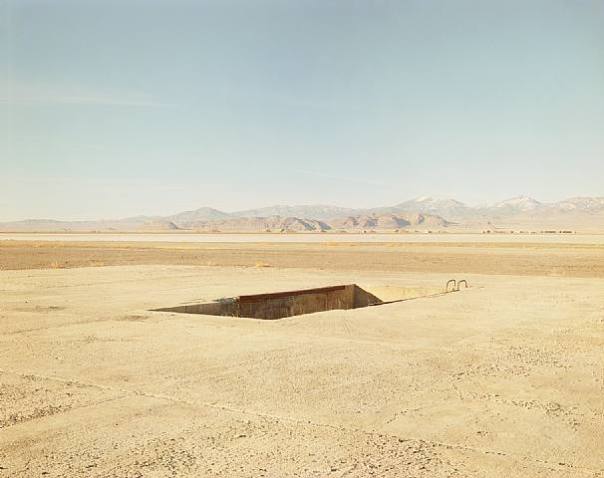
I have been going to the California desert – on a pretty regular basis – for about 35 years. The great majority of that time has been when the light was hot and flat, washed out, the colors dull. Almost every photographer working in the desert shoots during what is called the sweet light or golden hour – between about an half hour before sunrise to about two hours after sunrise and the reverse – sort of – around sunset. Richard Misrach shoots during the middle of the day when the light is flat and washed out and his photographs looks like the desert actually seems to look when most people are actually looking at it.
Most “fine art photographers” tend to not use normal lenses, especially in the desert, with the wide angle being a perennial favorite. So there is some point of interest in the foreground but the real photograph is often the background. Art Wolfe is a terrific photographer; he is a photographer who does – more or less – conventional images in a conventional way better than anybody. I love his shots but their strength is that they are not what most people see when they go to the desert.

Richard Misrach strength is that his shots show what most people see and are impacted by in the desert.
I love Misrach – his images – and he has had a huge impact on my photography but I have never been quite sure why I am so attracted to them. I have never been sure how he made them work. Over the weekend, we saw the same Misrach photographs displayed at both the Oakland Museum and the Berkeley Art Museum. (It was interesting how the same photographs took on a different feel – tone is better – when they are displayed differently. I preferred the Oakland show, BTW.) More importantly, for me, the two shows helped me understand Misrach’s photography much better.
Now, I think that the genius of Misrach is not in the content of his photographs – which are often pretty mundane – but in how that photograph is played, for lack of a better word. First his images – photo talk for pictures – are huge – like five by six feet huge – and that makes a big difference. And sharp; 8″ by 10″ camera sharp (or, if shot today, huge megapixel sharp). It is easy to almost get lost in the photographs, they almost become a real life view. He has had the guts to just go for an outrageous size and the impact is worth it (except that they are too big for most homes. Second, the images are desaturated. Just like the desert light, at any time but the golden hour, is desaturated.
It will be fun to see how this plays out in my photography.


Like you, Steve, I really dig both the desert and Richard Misrach’s work.
I agree, the LARGE prints tend to suck you right into them…it’s intoxicating.
Thanks for the posting; it makes me want to get out there!
Pretty amazing photographs Steve!